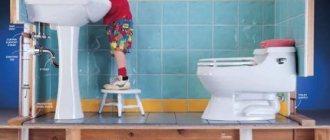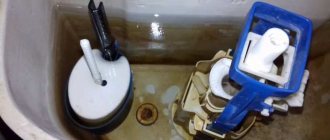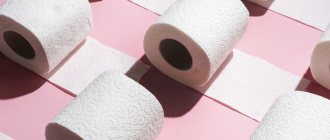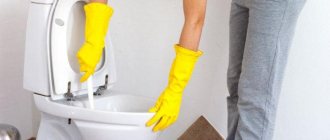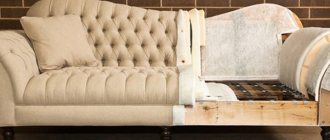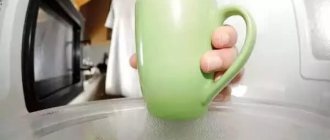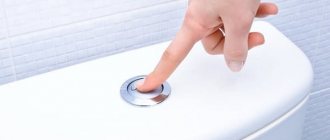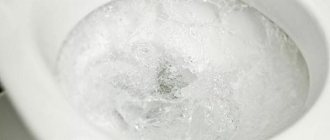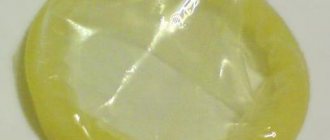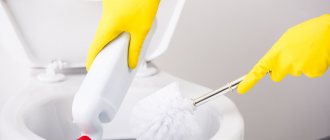Blockages in modern toilets occur infrequently, most often due to improper use of plumbing. If the pipes are still clogged, they can be cleaned using improvised means.
For small blockages, using traditional methods or household chemicals is suitable; for complex cases, you will have to clean the toilet mechanically: yourself or call a plumber. What exactly means are needed if the toilet is clogged, and what to do first, depends on the cause of the blockage.
Why does the toilet clog?
There are several reasons why plumbing systems become clogged:
- improper operation - pouring food, household, construction waste, cat litter, plastic bags, etc. into the toilet;
- defects in the installation of plumbing - if the toilet is not connected to the sewer correctly, dirt often accumulates in the pipe;
- salt deposits in pipes - formed due to insufficient care of plumbing. The risk of their occurrence increases if the tap water in the region is characterized by increased hardness.
The first reason is the most common. You can deal with it yourself. Also, calling a plumber will most likely not be necessary if the stagnation is due to salt build-up.
There is no need to finish this work of art.
Cleaning the toilet begins, for now, with the most harmless material - soda
First you need to determine the cause of the blockage and its location.
Causes
Among the reasons, we identify three, the nature of which, however, is the same - our disregard for the house, ours or someone else’s, is no longer so important here:
- Firstly, we ourselves threw in potato peelings, watermelon or melon peels, dropped rags or a whole roll of toilet paper.
- Secondly, we hired builders who don’t care what opinion they leave their customers with. Completing the work, they decided to solve the problem of cleaning up all construction waste radically - through the toilet;
- Thirdly, you are unlucky with neighbors who do not hesitate to throw everything they find down the toilet, instead of taking the garbage outside to the trash can.
Place
Only in the latter case, the place of contamination will be practically inaccessible to you - it is already in the common house sewer, and the problem of how to clean the toilet will disappear for you by itself, you will have to contact the housing office.
In all other cases, there are five possible places where garbage can accumulate:
- in the primary canal to the siphon;
- in the siphon (place “A” in the diagram);
You can also clean the toilet with a commonly used “punch” called a “plunger.”
- in the channel before exiting into the sewer pipe;
- at the junction of the toilet with the sewer (B in the diagram);
- at the junction of the house pipe with the house manifold.
How to determine the location of the blockage
Before you know what to do if your toilet is clogged, you need to determine where the clog is and how serious it is. To do this you will need:
- Find out whether the clogged pipe is leaking water or is completely clogged.
This can be seen if you pour about a liter of water into the toilet and check after 15 minutes whether the level has dropped. If this happens, then the blockage is not severe. You should not drain the contents of the tank to assess the congestion - there is too much water in it.
- See if the problem is local or extends to the entire sewer system.
To do this, you need to run water from the taps in the kitchen and bathroom. If it quickly goes down the drain, then the blockage should be looked for in the pipes near the toilet.
If the water does not drain in any of the bathrooms in your apartment, there is no need to rush to clean the riser - it rarely gets clogged.
First you need to go down to the neighbors below and find out how things are going with them - if everything is in order, then the problem is in the section of the pipe from you to the lower floor
If your neighbors have the same picture as yours, then you need to go even lower and so on - to the first floor
Types of cables
Depending on the purpose, as well as the complexity of the blockage, there are several types of sewer cables.
Cable
Cable. The diameter of such a tool is 6 mm; galvanized steel is used for manufacturing, and the optimal value does not exceed 5 meters (this is quite enough for apartment sewerage). The factory usually crimps the end of such a cable, but among plumbers it is practiced to give it a brush shape, as this helps remove wool, hair and other causes of blockage. This design has excellent characteristics, namely high strength, durability, excellent elasticity and flexibility. Thanks to these qualities, the cable passes freely into a pipe, bend or sewer joint. But there is also a significant drawback - the rope cable is too soft, which is why it is unlikely to cope with a serious blockage.
Flexible
Flexible plumbing cable , as well as flexible shaft or flexible hose. This device is much more convenient and effective than a rope cable. The design is as follows: a metal spiral is wound on top of the steel core in 1 or several layers. The permissible length of the product is 60 m, and the diameter is up to 28 mm.
Metal tape
Metal tape is also a type of plumbing rope. Available complete with tip and handle. The length of the product reaches 30 m, and the width – up to 25 mm.
Spring
Spring-loaded. The length of this type of cable is 6 meters and the diameter is 9 mm. In accordance with the category, it can be called household, and its design is based on a hollow steel spring.
Note! If the diameter of the plumbing cable is 13.5 mm and the length is 25 meters, then it is already professional equipment capable of cleaning a riser pipe or any other horizontal pipe.
Tensioner
Tension. The design of a plumbing spring cable is represented by a flexible shaft wrapped in spring-type wire. It was called tension because when you turn the handle it becomes rigid, like a rod. This tool is professional, as it can cope with complex blockages that were beyond the capabilities of an ordinary cable. A special drum is used to carry and store all-metal and steel ropes in vinyl braid.
Electric
Electric cables , which look like a whole installation, are used to clean large diameter sewer pipes. The electric model looks like a cable equipped with a pistol-type tip and handle, wound on a special drum. Such a tool is capable of clearing any pipe, even the most severe blockage.
The price of a plumbing cable for clearing sewer blockages is mainly influenced by the model and the chosen manufacturer.
Folk remedies
Traditional methods help if the toilet is clogged due to all kinds of deposits. Such products dissolve the blockage, so that the drain water quickly returns to the sewer.
Boiling water
The easiest way to clean a toilet is to pour boiling water into it. You will first need to pump out the liquid remaining in the toilet. Then you need to pour 1-2 liters of water inside. It is important to pour boiling water quickly so that a kind of pressure is formed.
You should be careful when using this method. Cracks may appear on the toilet.
During manipulation, splashes may fly off and cause burns. It is also necessary to remember that it is strictly forbidden to use boiling water for plastic pipes.
Soda and vinegar
When traffic jams in pipes are caused by an accumulation of organic matter or salt deposits, a mixture of soda and vinegar will help:
- Place half a pack of soda inside the toilet.
- Then pour in 1 liter of table vinegar.
- Close the drain and leave it for 2 hours.
- After this time, pour boiling water inside. Leave to act for another hour.
Then drain the tank and check if the blockage is cleared.
Alkali
A more effective option for unclogging a toilet is to use caustic soda. It quickly removes even long-standing deposits:
- Mix 2 kg of caustic soda with 5 liters of cold water.
- Pour the prepared solution into the toilet hole and wait. The waiting time ranges from 5 minutes to an hour - it all depends on the location of the traffic jam.
- Then pour boiling water inside and drain the tank after an hour.
When working with alkali, it is necessary to use protective equipment - the caustic substance causes severe irritation if it comes into contact with the skin.
Pepsi and cola
If the toilet is clogged, popular drinks like Pepsi and Coca-Cola are practically useless.
They can be used for small traffic jams and as a last resort - when there are no other means at hand. A bottle of soda is poured into the toilet and left to act for a period of 12 hours. If after this time the results are not noticeable, you will need to turn to other methods.
Mustard
A mustard solution prepared in boiling water will help break through simple blockages:
- Take 6-8 liters of liquid and add 4-6 teaspoons of mustard powder. Stir until dissolved.
- The liquid is poured into the toilet.
- Leave to act for 30-60 minutes.
If it is not possible to completely break through the clogged pipes, the procedure should be repeated.
Fairy tricks
You can try to fix the problem using Fairy or another fat-dissolving dishwashing detergent.
Such chemistry will only be useful if fat has actually accumulated on the walls of the pipes. But this is not typical for the sewer leading to the toilet.
When do you need a plumber
In difficult cases, such as all the pipes are clogged, you will not be able to break through the blockage yourself. A sign of a severely clogged toilet is when flushed waste floats up through drains in bathtubs or sinks.
If neighbors also complain about such a problem, then the cause must be looked for in the sewer system outside the apartment. Only a plumber can remove such a blockage.
You will also need the help of a specialist if the listed pipe cleaning methods, including chemical ones, do not work. The plumber will find out the reason for the stagnation of water and break through the mud blockage.
Preventing blockages
Preventing toilet blockages is easier than hassling with removing them. To do this, it is important to adhere to several rules:
- do not flush food, personal hygiene items, or cat litter into the toilet;
- periodically clean the plumbing fixtures with chemicals - the terms of prevention are indicated on the packaging;
- Clean the toilet with hot water every day.
If you follow the rules for using plumbing and take care of it, then blockages will be a very rare occurrence in the house.
What is the difference between electric and manual models
The electrical model of a plumbing cable is most often used by professional plumbers. This device allows you to quickly detect the source of pollution and also destroy its structure.
The following characteristics are considered to be the advantage of the electric drive model:
- Availability of torque;
- Excellent balance between flexibility and elasticity of the working part;
- Quick and safe removal of debris;
- Effective cleaning;
- The device perfectly replaces a brush and a plunger.
A significant disadvantage of this model is the rapid deformation of the tip, without replacement of which the metal base may deteriorate.
Regular maintenance of the working part of the tool allows you to increase the performance characteristics of the product. To do this, it is enough to clean the working surface, lubricate it and carefully inspect the surface.
